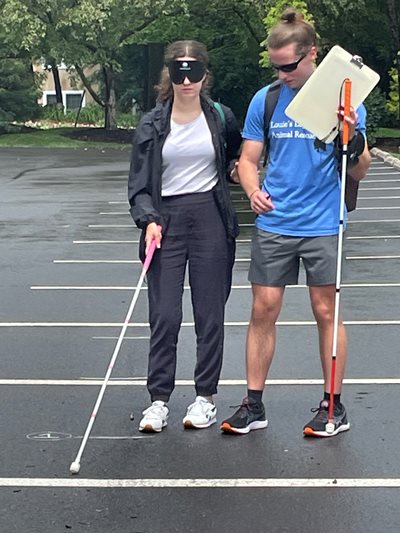During the eight-week summer residency program for Blindness and Low Vision (BLVS) students at Salus University, it’s not unusual to see Orientation and Mobility (O&M) students in a vacant area of the Elkins Park, Pennsylvania campus parking lot with blindfolds and white canes.
 What they’re doing is building awareness of crossing time which is important when travelers with visual impairment encounter an unfamiliar intersection. After analysis, which includes determining the number of lanes for the street to be crossed, the traveler then has an “internal awareness of the approximate amount of time it will take to cross the street,” said Jamie Maffit, MS, COMS, CLVT, RYT, director of the O&M program at Salus.
What they’re doing is building awareness of crossing time which is important when travelers with visual impairment encounter an unfamiliar intersection. After analysis, which includes determining the number of lanes for the street to be crossed, the traveler then has an “internal awareness of the approximate amount of time it will take to cross the street,” said Jamie Maffit, MS, COMS, CLVT, RYT, director of the O&M program at Salus.
One student, Anissa Najm ‘24O&M, explains the importance for those who are blind or visually impaired to know how far and how long they need to go to get across the street.
“I’ve learned that it is hard to trust your gut when you are not trying to count steps because as sighted people we are very reliant on visual cues when we cross streets,” she said. “But once you tune into your instincts, things become easier.”
The students work in pairs, with the one blindfolded walking the width of the lane with a partner without the blindfold indicating when to start, when they have reached the middle point and when they have crossed the width of one lane, using a stop watch to determine how long it takes.
“Not relying on counting steps is the hardest thing,” said Elaine Covaliuc ‘23VRT, ‘24O&M. “So, to minimize risk, we try to tune in to our instincts and intuition and trust that time and space.”
Not only do the students practice in the Salus parking lots, but they also train crossing streets in Philadelphia and the Chestnut Hill neighborhood, where they apply what they’ve learned to real-world environments including residential, small business and metropolitan areas, Maffit said.
“It’s something that is introduced and reinforced over time. With O&M, it’s an ongoing learning experience,” she said. “You scaffold the learning and you build on the concepts and skills. This is step one.”